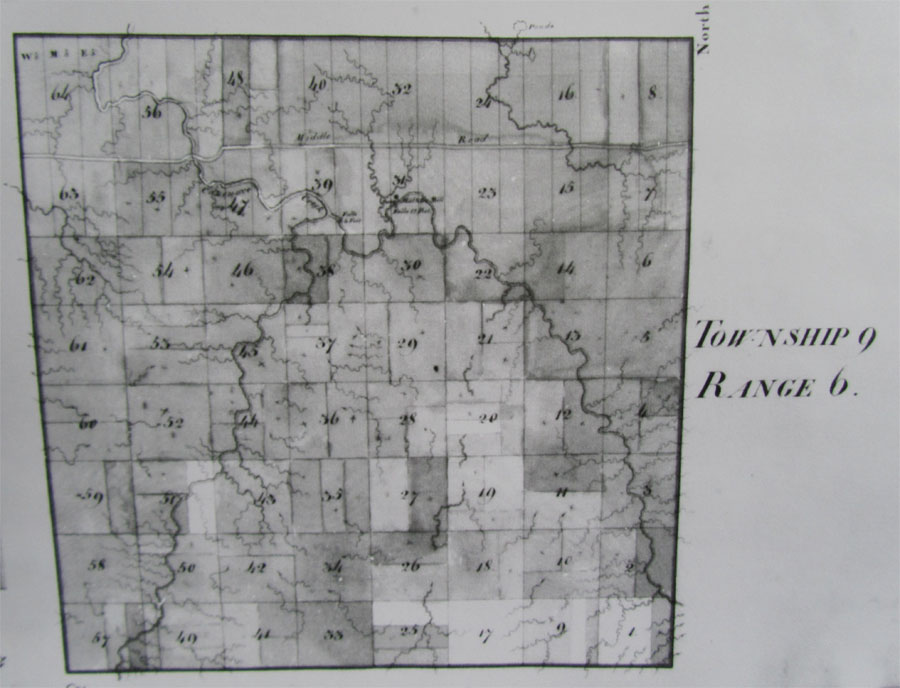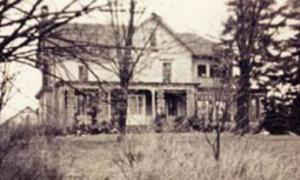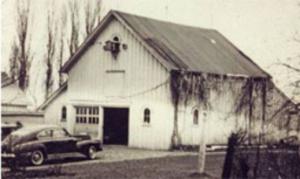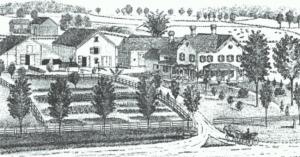Property History
The Lilacs is located in the Town of Aurora in Erie County, on the southeastern corner of Lot 16, Township 9, Range 6 of the Holland Land Company survey.
.jpg)
Morris Purchase – 1804

Township 9, Range 6
When Joseph Ellicott was hired by the Holland Land Company in 1800 to survey and manage the Holland Land Purchase of western New York, he divided the land into townships and ranges. Ranges were set at 6 miles wide and ran from Lake Ontario to the Pennsylvania border, and numbered from east to west (1-15 in all). With some variation, townships were generally set at 6 miles square and numbered from north to south. Townships generally consisted of 64 lots containing 360 acres each. It was common for each lot to be divided into 3 sections of 120 acres each to facilitate land sales. The Holland Land Company started selling land in this area in 1804, although sales rapidly increased after 1824.
The earliest land records we can find for this property show that Joseph & Sally Blakeley purchased at least 166 acres in the southeast part of Lot 16 from the Holland Land Company, sometime prior to 1826. They homesteaded on the 166 acres and established a farm.
The Holland Land Company recorded land sales on credit as Purchase Money transactions, and issued Deeds to property only upon full payment. It was common for land sales to be made on credit. As the Purchaser made payments on the land purchase, the Holland Land Company issued deeds on the portion of the land cleared of indebtedness, and then typically recorded the remaining acreage under debt as a “renewed sale”.
Joseph & Sally Blakeley received Deed to 40 acres in Feb 1826. They subsequently obtained Deed to another 35 acres in Feb 1828 and, on the same day, sold 20 acres to Elizabeth Williams.
The 20 acre parcel sold to Elizabeth Williams was in the southeast corner of Lot 16, bordering on the original road that had been constructed to provide settlers access from the Finger Lakes to Lake Erie - Middle Road (aka Big Tree Road). That parcel ultimately became known as The Lilacs, and remained intact (with a few minor adjustments along the way) until the estate went into a period of decline and started to be broken up, with portions of the property sold off starting in the 1960s. As far as we can determine, it appears that this property continued to be a working farm until at least the 1890s.
This property has been marked by somewhat frequent turnover of ownership. There have been 18 different owners since the property was purchased from the Holland Land Co. Although The Lilacs humble origins was as a farmstead in the early 1800s, it had become one of Erie County’s notable residences by the latter part of the 19th century. Indeed, the list of owners reflects the latter 19th century and early 20th century change in Western New York from an agricultural economy to an industrial economy, and the rise of the upper middle class due to the significant wealth generation that industrialization ushered in. Included in the list of owners were a number of very prominent families, having achieved great success in a variety of industries, such as agriculture, retail, banking and other commercial ventures. Our research of these owners has found that many of them shared similar attributes – traditional faith and strong supporters of their churches; and strong sense of commitment to the well-being of their fellow man and the greater community. See the History of Ownership section for information on the various owners.
There have been many changes to The Lilacs – both buildings and grounds - over the years. Many of these changes reflected the various owners’ intentions and ideas relative to how and what they wanted in their daily family lives. Individually, and together in total, they not only developed a house and landscape, but also created an ambience that still endures today.
The original 20 acre farm had grown to 22 acres at the outset of the Schreiber ownership in the 1917-18 timeframe. Relative to the break-up of the estate, the major sale of property occurred in 1977 when approximately 14 acres of the rear of the property (north end) was sold off for a housing development. Portions of the remaining 8 front acres (bordering Big Tree Road) on both sides of the grand house were split into separate residential properties between the early 1960s and 1980s. The Lilacs now consists of the grand house and cottage on approximately 2.5 acres.


During the first half of the 20th century, the house and gardens gained notable fame, which was recognized well beyond the local area. Substantial landscaping improvements resulted in The Lilacs being featured in several periodicals of that time, including the book “Buffalo, The City Beautiful, Its Homes, Gardens and Environs” published in 1931.


The ‘grand’ era of The Lilacs came, if not to an end, at least to an extended halt, with the passing of the last ‘grand’ owner in 1938. The same vision and energy to maintain the house and grounds did not continue, and the property sadly devolved. Subsequent decades saw the property on an extended period of decline and deterioration. The house ceased being a one family residence and became a multi-tenant facility.
The impressive complex of barns and silos, no longer used or maintained, deteriorated over time and were demolished during the 1970s. The grand house itself, having deteriorated to the point of being on life support, became a candidate for demolition. However, the 1980s heralded a new beginning, at which time the first steps in the long process of rehabilitation and restoration commenced.
The house is believed to date to c1850, and extensive alterations were made in 1908 by the well-known Buffalo architectural firm of Green & Wicks.

An artist’s sketch of this remarkable property appeared in the 1880 Atlas of Erie County.
The cottage (guest house) was constructed in the autumn of 1881 by the Griggs family as a tenant house. It was situated by Big Tree Road close to Tannery Brook, and was moved in 1918 to its present location behind the grand house and next to where the complex of barns stood, for use as the residence for the property owner’s chauffeur (the barn was used as a garage for the autos).